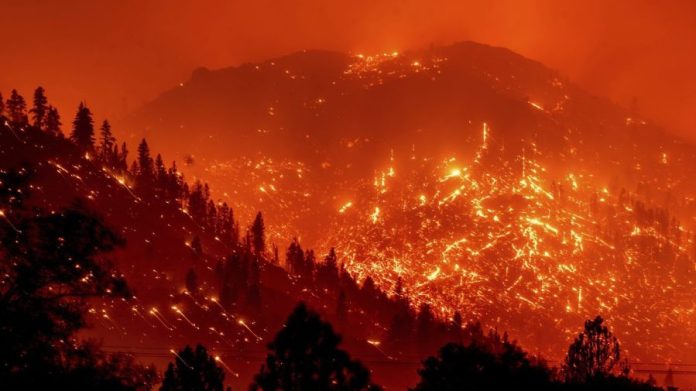
The threat of high-severity wildfires in forests controlled by private timber companies may be much greater than in those managed by public lands agencies, a new study has found.
That risk was nearly one-and-a-half times higher in surveys conducted across California’s northern Sierra Nevada, scientists determined in the study, published on Wednesday in Global Change Biology.
Forests managed by timber companies, the authors observed, were more likely to exhibit ideal ignition conditions for megafires: dense communities of uniformly spaced trees, with continuous vegetation that connects the understory to the canopy.
“You can think about stacking a bunch of matches together in a grid —that’s going to burn a lot better than if you have those matches dispersed as smaller clumps,” lead author Jacob Levine, a postdoctoral researcher at the University of Utah, said in a statement.
Levine and his colleagues leveraged a unique dataset available via a multiagency federal effort to deploy airborne light detection and ranging (LiDAR) sensing systems.
Specifically, in 2018, the U.S. Forest Service, the U.S. Geological Service and NASA decided to begin surveying California’s Plumas National Forest and surrounding private lands using this LiDAR flight technology.
The technology works by emitting billions of laser pulses — which then bounce off the grass, shrubs, saplings, tree canopies and other forest structures — and then measuring with high-precision how much time the light takes to return. These measurements can then provide accurate assessments of distances, terrain elevation and other relevant information.
Plumas National Forest, the authors explained, is emblematic of a broader trend of wildfire occurrence and intensity — and “a mosaic of private industrial and public ownership.”
The region’s mixed conifers have adapted to periodic low- to medium-severity blazes that scorch vegetation and leave behind clumps of trees, the researchers noted. But efforts since the 1800s to boost U.S. timber production and suppress fires, they explained, have disrupted natural fire cycles and increased fodder for future blazes.
About 70 percent of the study area was burned in five massive blazes between 2019 and 2021, including the 2021 Dixie Fire — the single biggest fire in California’s recorded history, according to the study.
And it just so happens — in a manner that the authors described as “serendipitous” — that the multiagency LiDAR dataset was collected the year before these blazes began.
“We have a really detailed picture of what the forest looked like immediately before these massive fires,” Levine said.
Levine and his team analyzed the patterns of burn severity in the five fires, which collectively burned about 1.1 million acres within Plumas National Forest. The fires all began on public land, but their effects were far more severe in the privately owned areas.
About 81.6 percent of the study area was managed by public land agencies, while just 11.7 percent was owned by private industrial timber companies and 6.6 percent by non-industrial private entities, according to the study.
Private industrial ownership, the authors found, was associated with a 1.45-times surge in the odds of high-severity fire in comparison to publicly owned land and a 2.1-times increase relative to the non-industrial private zones.
They also discovered that the heightened risks applied to areas near, but not owned by, the private industrial companies — posing a threat to the wilderness, to small landowners and to adjacent urban communities.
“A bigger fire can easily reach the canopy in dense forests,” Levine said. “Then it’s ripping through one tree after another, tossing out chunks of burning material miles in advance.”
Different from the grid-like forests controlled by the timber industry, public lands tend to be used for a wider range of purposes, including grazing, recreation, restoration and wildlife corridors, the authors noted. These lands, they explained, are also beholden to the public and environmental lawsuits, which often sue to stop tree removals.
The researchers expressed hope that their findings could help adjust policies governing landscape management — and thereby steer the way blazes burn through such woodlands.
Thanks to their access to the forest data from before and after the blazes, Levine said that the researchers were able to understand the types of forest structures that lead to high-severity blazes.
That knowledge, in turn, enables stakeholders “to target mitigation strategies to get ahead of this massive fire problem while still producing enough timber to meet market demand,” Levine added.

